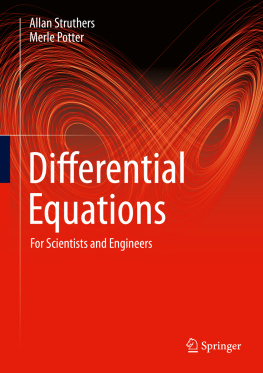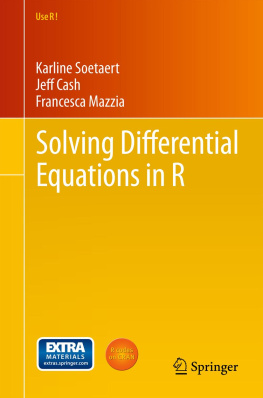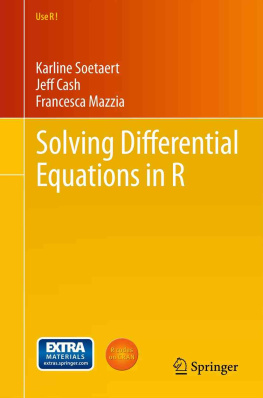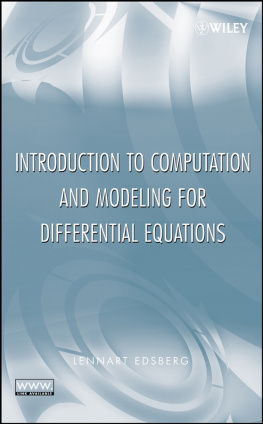Table of Contents
Pages
Guide
List of Illustrations
- Chapter 1: Overview of Engineering Analysis
- Chapter 2: Mathematical Modeling
- Chapter 3: Vectors and Vector Calculus
- Chapter 4: Linear Algebra and Matrices
- Chapter 5: Overview of Fourier Series
- Chapter 6: Introduction to the Laplace Transform and Applications
- Chapter 7: Application of First-order Differential Equations in Engineering Analysis
- Chapter 8: Application of Second-order Ordinary Differential Equations in Mechanical Vibration Analysis
- Chapter 9: Applications of Partial Differential Equations in Mechanical Engineering Analysis
- Chapter 10: Numerical Solution Methods for Engineering Analysis
- Chapter 11: Introduction to Finite-element Analysis
- Chapter 12: Statistics for Engineering Analysis
- Appendix 4: Application of MATLAB Software for Numerical Solutions in Engineering Analysis: Contributed by Vaibhav Tank
List of Tables
- Chapter 1: Overview of Engineering Analysis
- Chapter 7: Application of First-order Differential Equations in Engineering Analysis
- Chapter 8: Application of Second-order Ordinary Differential Equations in Mechanical Vibration Analysis
- Chapter 9: Applications of Partial Differential Equations in Mechanical Engineering Analysis
- Chapter 10: Numerical Solution Methods for Engineering Analysis
- Chapter 11: Introduction to Finite-element Analysis
- Chapter 12: Statistics for Engineering Analysis
Applied Engineering Analysis
Tai-Ran Hsu
San Jose State University, San Jose, USA
This edition first published 2018
2018 John Wiley & Sons Ltd
All rights reserved. No part of this publication may be reproduced, stored in a retrieval system, or transmitted, in any form or by any means, electronic, mechanical, photocopying, recording, or otherwise, except as permitted by law. Advice on how to obtain permission to reuse material from this title is available at http://www.wiley.com/go/permissions.
The right of Tai-Ran Hsu to be identified as the author of this work has been asserted in accordance with law.
Registered Office(s)
John Wiley & Sons, Inc., 111 River Street, Hoboken, NJ 07030, USA
John Wiley & Sons Ltd, The Atrium, Southern Gate, Chichester, West Sussex, PO19 8SQ, UK
Editorial Office
The Atrium, Southern Gate, Chichester, West Sussex, PO19 8SQ, UK
For details of our global editorial offices, customer services, and more information about Wiley products visit us at www.wiley.com.
Wiley also publishes its books in a variety of electronic formats and by print-on-demand. Some content that appears in standard print versions of this book may not be available in other formats.
Limit of Liability/Disclaimer of Warranty
While the publisher and authors have put their best efforts in preparing this work, they make no representations or warranties with respect to the accuracy or completeness of the contents of this work and specifically disclaim all warranties, including without limitation any implied warranties of merchantability or fitness for a particular purpose. No warranty may be created or extended by sales representatives, written sales materials, or promotional statements for this work. The fact that an organization, website, or product is referred to in this work as a citation and/or potential source of further information does not mean that the publisher and authors endorse the information or services the organization, website, or product may provide or recommendations it may make. This work is sold with the understanding that the publisher is not engaged in rendering professional services. The advice and strategies contained herein may not be suitable for your situation. You should consult with a specialist where appropriate. Further, readers should be aware that websites listed in this work may have changed or disappeared between when this work was written and when it is read. Neither the publisher nor authors shall be liable for any loss of profit or any other commercial damage, including but not limited to special, incidental, consequential, or other damage.
Library of Congress Cataloging-in-Publication Data
Names: Hsu, Tai-Ran, author.
Title: Applied engineering analysis / by Tai-Ran Hsu.
Description: Hoboken, NJ : John Wiley & Sons, 2017. | Includes bibliographical references and index. |
Identifiers: LCCN 2017017185 (print) | LCCN 2017037252 (ebook) | ISBN 9781119071181 (pdf) | ISBN 9781119071198 (epub) | ISBN 9781119071204 (cloth)
Subjects: LCSH: Engineering mathematics-Textbooks.
Classification: LCC TA332.5 (ebook) | LCC TA332.5 .H78 2017 (print) | DDC 620.001/51-dc23
LC record available at https://lccn.loc.gov/2017017185
Cover design by Wiley
Cover image: (Sir Isaac Newton) duncan1890/Gettyimages; (Hand) Colin Anderson/Gettyimages
My wife Grace Su-Yong who has supported me for decades with endless encouragement and love, my three loving adult children, Jean, Euginette, and Leigh, for their consistent support, and above all, my motivated students who inspired me to write this book.

Preface
This book is designed to be a textbook for a one-semester course in engineering analysis for both junior and senior undergraduate classes or entry-level graduate programs. It is also designed for practicing engineers who are in need of analytical tools to solve technical problems in their line of duties. Unlike many textbooks adopted for class teaching of engineering analysis, this book introduces fewer additional mathematical topics beyond the courses on calculus and differential equations, but has heavy engineering content. Another unique feature of this book is its strong focus on using mathematics as a tool to solve engineering problems. Theories are presented in the book to show students their connection with practical issues in problem-solving. Overall, this book should be treated as an engineering, not advanced engineering mathematics textbook.
Mathematics and physics are two principal pillars of engineering education of all disciplines. Indeed, courses in mathematics and physics dominate the curricula of lower division engineering education in both the Freshman and Sophomore years in most engineering programs worldwide. Many engineering schools offer a course on engineering analysis that follows classes on precalculus, calculus, and differential equations. Engineering analysis is also offered at the entry level of graduate studies in many universities in the world.
The widespread acceptance of engineering analysis as a core curriculum by many educators is attributed to their conviction that students need to synergistically integrate all of the mathematical subjects that they learned earlier and apply them in solving engineering problems. However, the pedagogy of engineering analysis and its outcome has rarely been discussed in open forums. Many universities offer a course on engineering analysis as a terminal mathematics course with additional advanced mathematics subjects. Consequently, all textbook vendors with whom I have had contact in the last 30 years have consistently published books on advanced engineering mathematics, as textbooks for my course on engineering analysis. Upon close inspection, almost all have little direct relevance to the engineering profession. Additionally, all of these books are close to, or exceed, 1000 printed pages, with overwhelming coverage of detailed and elegant mathematical treatments to mostly mathematical problems. I have also observed that in all of the advanced engineering mathematics books such as those cited in the bibliography of this book, less than 10 percent of the pages have applications to engineering problems. Consequently, a textbook that is designed to teach students to solve engineering problems using mathematics as a tool is truly needed in classes on engineering analysis or those with similar objectives.











